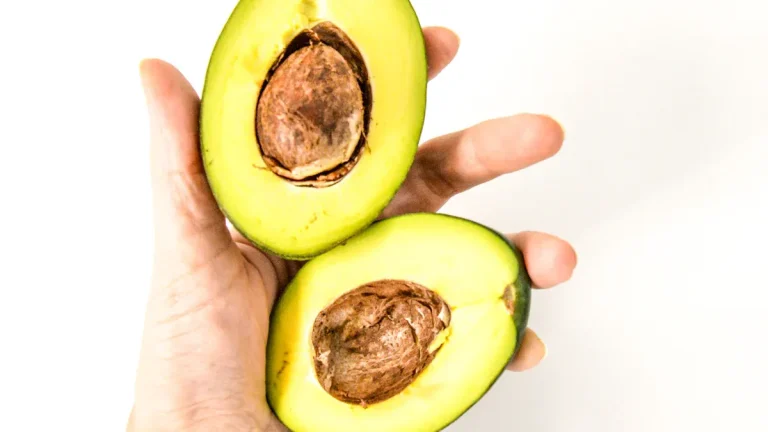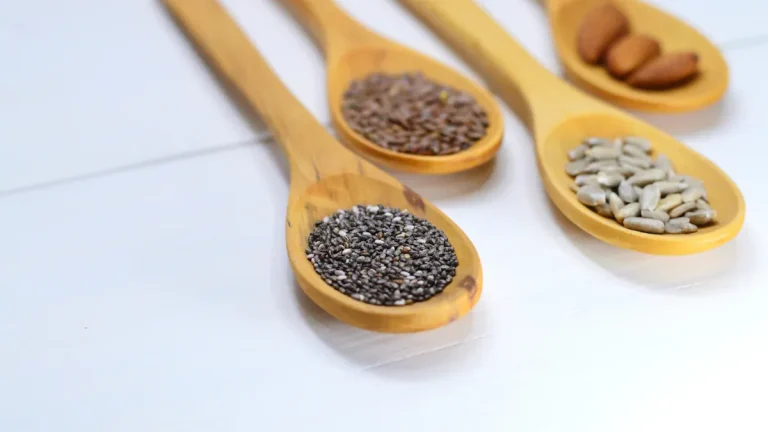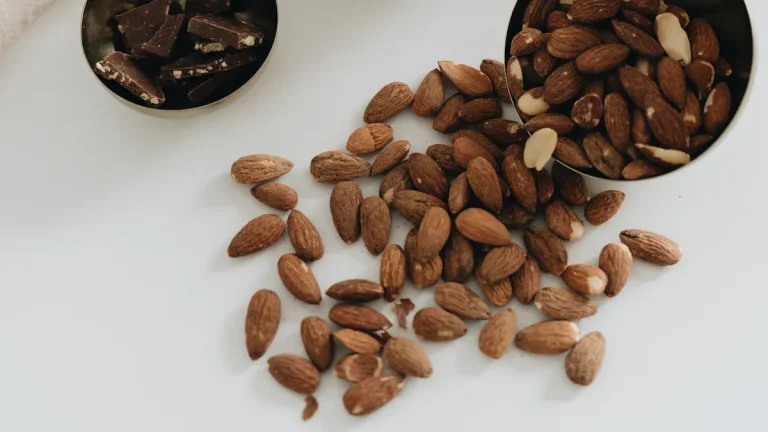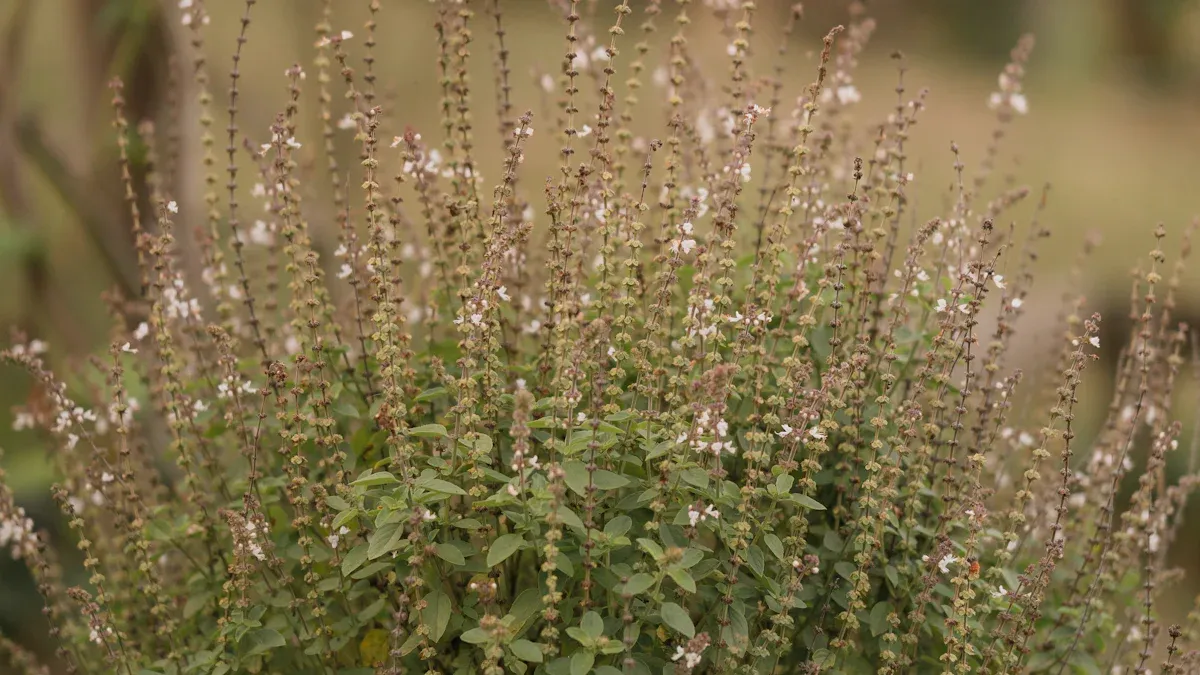
Curious about what makes holy basil special? Here are nine health benefits you can enjoy from this amazing herb:
Reduces stress and helps you feel calm.
Balances hormones to support your body.
Supports heart health.
Lowers blood sugar.
Heals wounds naturally.
Fights inflammation.
Clears skin for a healthy glow.
Relieves fever.
Delivers strong antioxidant action.
Check out this quick table showing how people feel better after using holy basil:
Study Duration | Stress Relief (%) | Better Sleep (%) |
|---|---|---|
6 weeks | 39 | — |
8 weeks | 37 | 48 |
You might notice more energy, less stress, and a brighter mood in your daily life!
Key Takeaways
Holy basil reduces stress and anxiety, helping you feel calmer and more relaxed.
This herb supports heart health by managing cholesterol levels and improving blood pressure.
Holy basil can lower blood sugar levels, making it beneficial for those with metabolic issues.
Using holy basil may enhance skin health by fighting acne and reducing inflammation.
Incorporate holy basil into your routine through tea, supplements, or cooking for maximum benefits.
Holy Basil Health Benefits

Reduces Stress
You might notice that holy basil helps you feel calmer during tough days. This herb works as an adaptogen, which means it helps your body handle stress better. People who take holy basil often report feeling less anxious and more relaxed.
Study Type | Dosage | Findings |
|---|---|---|
RCT | 1200 mg/day of O. tenuiflorum | Improvements in stress-related experiences |
Open-label trial | 500 mg O. sanctum twice daily | Significant improvements in anxiety and stress |
Animal studies | N/A | Promising potential seen in small human trials |
The main compounds in holy basil, like eugenol, ursolic acid, and rosmarinic acid, help your mind and body bounce back from stress. You may find yourself sleeping better and feeling more emotionally balanced after adding holy basil to your routine.
Balances Hormones
Holy basil supports hormone balance, which can help you feel more stable and energetic. It helps lower cortisol, the stress hormone, by up to 36% in just a few days. When your cortisol levels drop, you may notice fewer mood swings and better sleep.
Did you know? People who took holy basil for two months felt less anxious and had better hormone balance.
Holy basil also helps lower fasting blood sugar, which can support healthy insulin levels. This means your body can manage energy and stress more smoothly.
Supports Heart
Holy basil offers several health benefits for your heart. It helps manage stress, which is a big risk factor for heart problems. Some animal studies show that holy basil can lower cholesterol and improve blood lipid profiles.
Holy basil may reduce total cholesterol, LDL cholesterol, and triglycerides.
It may increase HDL cholesterol, which is good for your heart.
The herb’s antioxidants protect your heart tissues from damage.
Effect on Cholesterol | Description |
|---|---|
Total Cholesterol | May support healthy levels |
LDL Cholesterol | May help lower levels |
Triglycerides | May support healthy levels due to phytochemicals like flavonoids, ursolic acid, and eugenol |
You may also see improvements in blood pressure, thanks to holy basil’s anti-inflammatory and antioxidant effects.
Lowers Blood Sugar
If you want to keep your blood sugar in check, holy basil can help. Studies show that people with metabolic issues who take holy basil see a drop in fasting glucose levels. One trial found that taking 2,500 mg daily lowered both blood sugar and cholesterol in people with type 2 diabetes.
Holy basil works by:
Improving insulin sensitivity
Helping your liver store more glycogen
Slowing down the release of sugar into your blood after meals
You may feel more balanced energy and fewer sugar crashes during the day.
Heals Wounds
Holy basil helps your body heal wounds faster. The plant contains eugenol, ursolic acid, and rosmarinic acid, which all support skin repair and fight germs.
Component | Type | Properties |
|---|---|---|
Eugenol | Volatile oil | Antimicrobial, healing |
Ursolic acid | Triterpenoid | Promotes skin healing, enhances elasticity |
Rosmarinic acid | Phenylpropanoid | Antioxidant, healing |
Caryophyllene | Terpene | Antimicrobial |
Oleanolic acid | Triterpenoid | Antimicrobial |
You can use holy basil on cuts or scrapes to help them heal and keep infections away.
Fights Inflammation
Holy basil is a natural way to fight inflammation in your body. The plant’s extracts reduce swelling and help your immune system work better.
Study Title | Findings |
|---|---|
Evaluation of Anti-Inflammatory Properties of Herbal Aqueous Extracts | Holy basil extracts reduced inflammation and inhibited LDL oxidation. |
You may notice less joint pain or swelling if you use holy basil regularly. Its phenolic acids and flavonoids make it a strong choice for anyone looking to lower inflammation naturally.
Clears Skin
You can use holy basil to help clear up your skin. The herb’s antibacterial and anti-inflammatory properties fight acne and soothe redness. People use holy basil to treat breakouts, eczema, and even hair loss.
Holy basil kills bacteria that cause acne.
It provides antioxidants that help your skin look younger.
The plant may reduce pigmentation and calm irritated skin.
Property/Compound | Effect on Skin Conditions |
|---|---|
Antibacterial | Kills bacteria causing breakouts |
Antiviral | Helps combat viral skin infections |
Antifungal | Addresses fungal skin issues |
Anti-inflammatory | Reduces inflammation related to acne |
Eugenol | Active compound aiding in antimicrobial effects |
You might see a healthier glow and fewer blemishes after using holy basil in your skincare routine.
Relieves Fever
Holy basil is a traditional remedy for fever. People have used it for centuries to bring down high temperatures and ease symptoms of colds and flu.
Study Reference | Findings |
|---|---|
Baliga et al., 2013 | Holy basil is used for fever relief and has anti-inflammatory properties. |
Jamshidi & Cohen, 2017 | Supports use in managing respiratory ailments, including fever. |
Singh, Rehan, & Majumdar, 2001 | Highlights analgesic properties for fever symptom relief. |
Modern research shows that holy basil’s antiviral and anti-inflammatory effects support its use for fever and other respiratory issues.
Antioxidant Action
Holy basil is packed with antioxidants that protect your cells from damage. These antioxidants, like lutein, zeaxanthin, beta-carotene, and beta-cryptoxanthin, help fight free radicals. Free radicals can cause cell damage and raise your risk for diseases like cancer and heart disease.
Evidence Type | Description |
|---|---|
Antioxidant Activity | Holy basil extracts showed strong superoxide anion scavenging and reducing power. |
Methodology | Antioxidant activity was assessed using a β-carotene/linoleic acid system. |
Stability | Extracts maintained high antioxidative stability at neutral and acidic pH. |
You may notice more energy and better overall health when you add holy basil to your daily routine. Its antioxidant power is one of the top health benefits you can enjoy.
How to Use Holy Basil
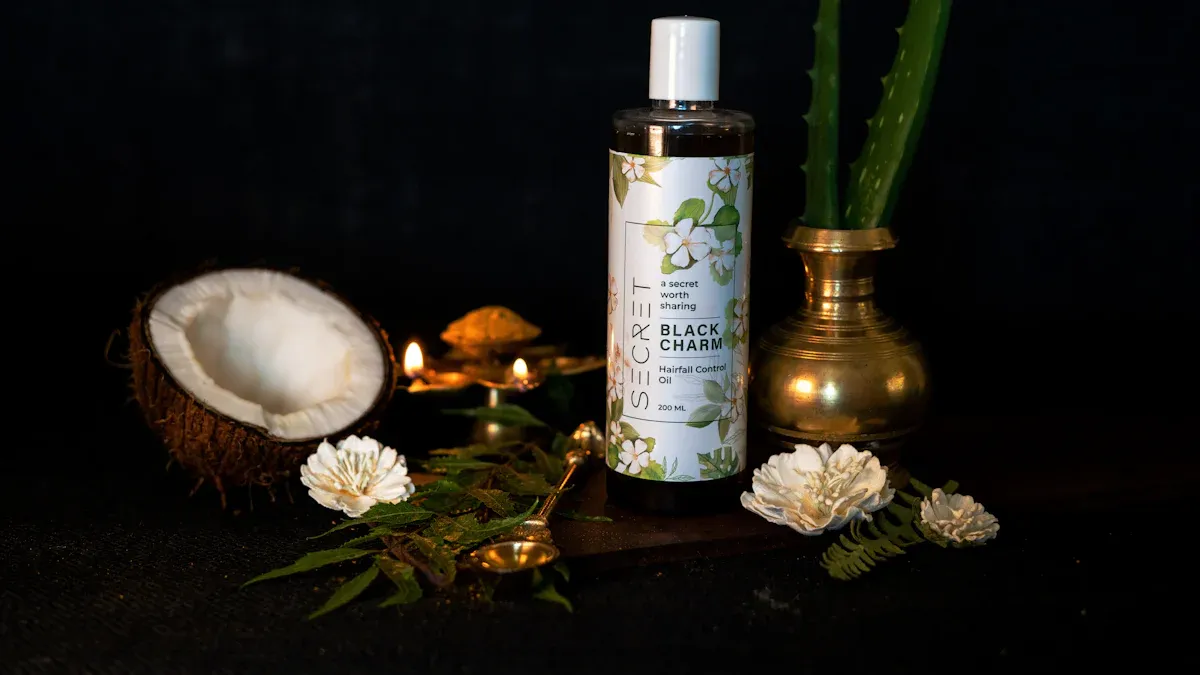
You have plenty of options when it comes to using holy basil. You can enjoy it as tea, take it as a supplement, or add fresh leaves to your meals. Each form brings its own set of Health Benefits.
Common Forms and Recommended Dosages
Check out this table to see the most common forms and how much you should use:
Form | Dosage | Duration |
|---|---|---|
Ethanolic extract | 300 mg/day | 30 days |
O. sanctum | 1,000 mg/day | 8 weeks |
O. tenuiflorum | 1,200 mg/day | 6 weeks |
O. sanctum | 250 mg twice daily | 8 weeks |
O. tenuiflorum | 5 mL, 4 times a day | 4 weeks |
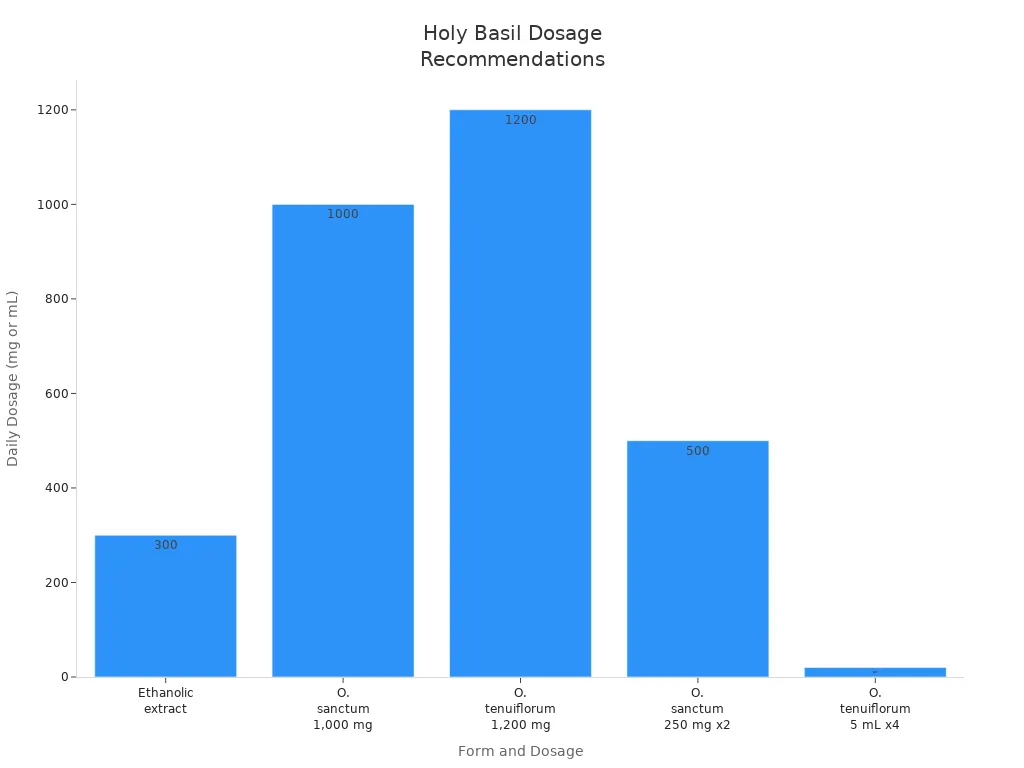
Simple Recipes with Holy Basil
You can try these easy recipes to add holy basil to your meals:
Tulasi Rasam: A South Indian soup with holy basil, tomatoes, and spices. Serve it with rice for a comforting meal.
Pad Kra Pao Gai: A Thai stir fry with minced chicken and holy basil. Spoon it over jasmine rice and top with a fried egg.
Practical Tips for Daily Use
Want to make holy basil part of your routine? Here are some ideas:
Brew holy basil tea with fresh or dried leaves for a soothing drink.
Toss fresh leaves into soups, stir-fries, or smoothies for extra flavor.
Mix ground holy basil with honey to make a calming face mask.
Take holy basil capsules for stress relief and immune support.
Steep leaves in water overnight for a refreshing, cooling drink.
Tip: Start with small amounts and see how your body feels. You can adjust the dosage as you get used to it.
You can choose the form that fits your lifestyle best. Try different recipes and tips to find what works for you.
Safety and Precautions
Before you start using holy basil, you should know what safety issues to watch for. Not everyone can use this herb safely. Here’s what you need to keep in mind:
Who Should Avoid Holy Basil?
Some people need to stay away from holy basil. You should avoid it if you fall into any of these groups:
Pregnant women
Breastfeeding mothers
Children under medical advice
People with bleeding disorders
Anyone scheduled for surgery soon
Those taking blood-thinning medication
Holy basil contains a compound called estragole. Large amounts may increase the risk of liver problems, especially during pregnancy or breastfeeding.
Note: If you are pregnant or breastfeeding, it’s best to skip holy basil. Safety for babies and mothers is not clear.
Possible Side Effects
Most people use holy basil without trouble, but some may notice side effects. Here’s what you might experience:
Upset stomach or nausea
Diarrhea
Low blood sugar
Increased risk of bleeding
Worsening of hypothyroidism
Decreased fertility
Some people also report feeling sleepy or having changes in blood clotting. If you notice anything unusual, stop using holy basil and talk to your doctor.
Safe Usage Guidelines
You can use holy basil safely by following a few simple rules:
Take only the recommended dose. Never double up.
Don’t chew holy basil leaves for more than a few minutes. Long chewing can harm your teeth.
Watch for drowsiness or bleeding. If these happen, call your doctor.
Use holy basil as a supplement, not a replacement for your regular medicine.
Tip: Always check with your healthcare provider before adding holy basil to your routine, especially if you take other medications or have health concerns.
You can enjoy many Health Benefits from holy basil, like less stress, better heart health, and stronger immunity. Check out this table to see how these benefits help you feel better:
Health Benefit | Description |
|---|---|
Stress and Anxiety Reduction | Tulsi lowers stress and anxiety, helping you relax. |
Immune System Support | Boosts your body’s natural defenses. |
Metabolic Stress Management | Helps control blood sugar and cholesterol. |
Antibacterial Properties | Fights germs and supports digestion. |
Detoxification | Helps your body remove toxins. |
Before you start, talk to your doctor. You should know about side effects, medicine interactions, and safety for pregnancy or thyroid issues. Try holy basil as tea or capsules, begin with a low dose, and watch how you feel. You can make holy basil part of your healthy lifestyle and feel your best every day! 🌱
FAQ
What is holy basil?
Holy basil is a green leafy herb. People call it “Tulsi” in India. You can use it for cooking, tea, or supplements. Many people believe it helps with stress and health.
What does holy basil taste like?
You will notice a peppery, slightly sweet flavor. Some people say it tastes a bit like cloves or mint. You can add it to soups, teas, or salads for extra flavor.
What can holy basil help with?
Holy basil may help you feel less stressed. It can support your heart, lower blood sugar, and clear your skin. Many people use it for fever and inflammation.
What is the best way to take holy basil?
You can drink holy basil tea, eat fresh leaves, or use capsules. Try adding leaves to your meals or smoothies. Start with a small amount and see how you feel.
What should you watch out for when using holy basil?
You should avoid holy basil if you are pregnant, breastfeeding, or taking blood thinners. Some people feel sleepy or get an upset stomach. Always talk to your doctor before you start.

